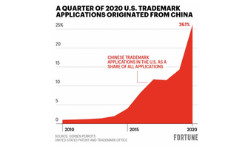In March 2019, we wrote with some concern, that as early as 2017 Chinese companies had filed more than 12 times the number of trademark applications with the USPTO than in previous years. At that time the director of the USPTO stated that “forecasts indicate that annual increases are expected to average 10% during the next 8 years.” The reason for the surge of trademark Chinese applications was a matter of speculation, but it was presumed to be related to the growing and expanding Chinese economy and, perhaps, subsidies paid by the Chinese government to register trademarks in the United States.
In August 2019, the USPTO created new rules among which was the requirement that foreign-domiciled trademark applicants must be represented by an attorney licensed to practice law in the United States. The goals of the rule were to:
- Increase USPTO customer compliance with U.S. trademark law and USPTO regulations.
- Improve the accuracy of trademark submissions to the USPTO.
- Safeguard the integrity of the U.S. trademark register.
Even these rules have not stopped the deluge of Chinese trademark applications. In July 2021, Fortune reported that Chinese trademark filings outpaced the growth of US filings. As of June 17, 2021, applications were up 63% from the previous year. According to Josh Gerben, a trademark attorney who has studied this phenomenon, China-based applicants account for 29% of all trademark applications; in 2010, they were responsible for only 1%. The sheer weight of these applications have profound effects upon the speed at which the USPTO can examine trademark applications. The new application wait time has increased from 4 months to 6 months before an examiner is even assigned to an application.
The USPTO attributes these trends to non-market factors including (1) subsidies created by the Chinese government to incentivize US trademark applications by Chinese businesses; (2) a mandate by the Chinese government to increase international trademark applications through the Madrid system; (3) an increase in the frequency of parties attempting to profit from registering trademarks in bad faith. Such applicants have no intention to use the applied-for trademarks, resulting in a slowdown of the US trademark application system; and (4) unused trademarks registered in good faith by legitimate brand owners, which are registered in an effort to counter feared bad-faith registrations of the same marks.
According to Gerben, the “most nefarious” theory behind the deluge of trademark applications is the US trade war with China. By making it harder to register trademarks and increasing the time and expense for US businesses, China pokes the US in the eye.
Another contributing factor may be the rise of Amazon as the preeminent international online marketplace. Four years ago, in 2017, there were an estimated 200,000 Chinese sellers on Amazon. One analyst in 2017 measured a 100% growth of Chinese sellers on Amazon in just the previous 6 months. In another report, dated January 2021, 75% of new sellers on Amazon were China-based. Although total numbers are hard to come by, one can assume that the number of Chinese-based sellers on Amazon is very large.
How does Amazon affect the rate of USPTO trademark filings? It is important to understand that the Amazon ecosystem favors products that have “legitimate” brands. According to the Patent and Trademark Blog, “one crucial factor in selling products under your own brand is to make sure you comply with Amazon’s intellectual property policy and block predators from using your brand.” The rush of Chinese vendors on Amazon would certainly increase the number of legitimate and illegitimate trademark filings in the USPTO. The impact of Amazon’s intellectual property policies on USPTO trademark application filings is a little-studied phenomenon but deserves more attention particularly with respect to the onslaught of Chinese trademark application filings.
We will continue to monitor the situation.
— Adam G. Garson, Esq.


